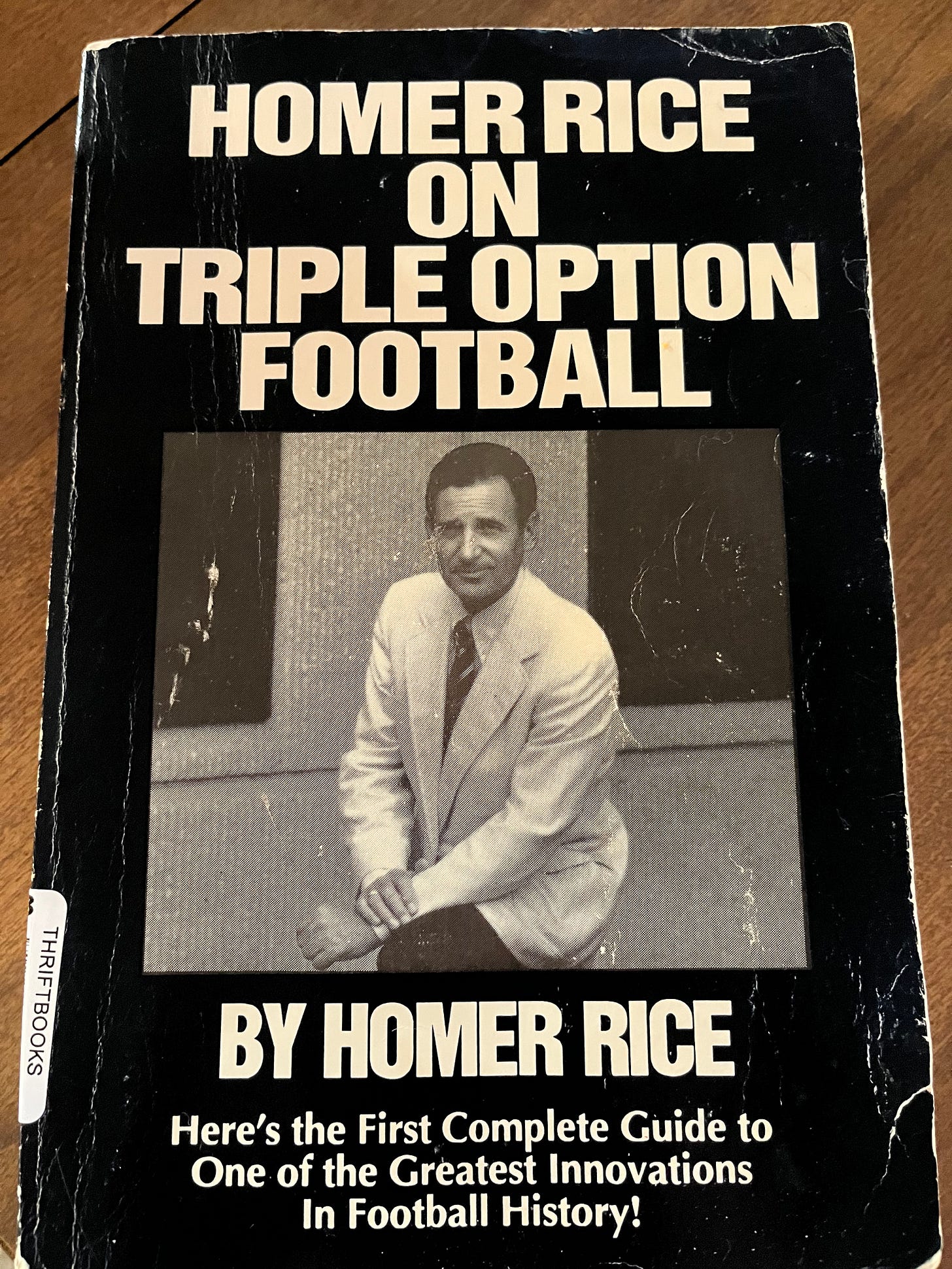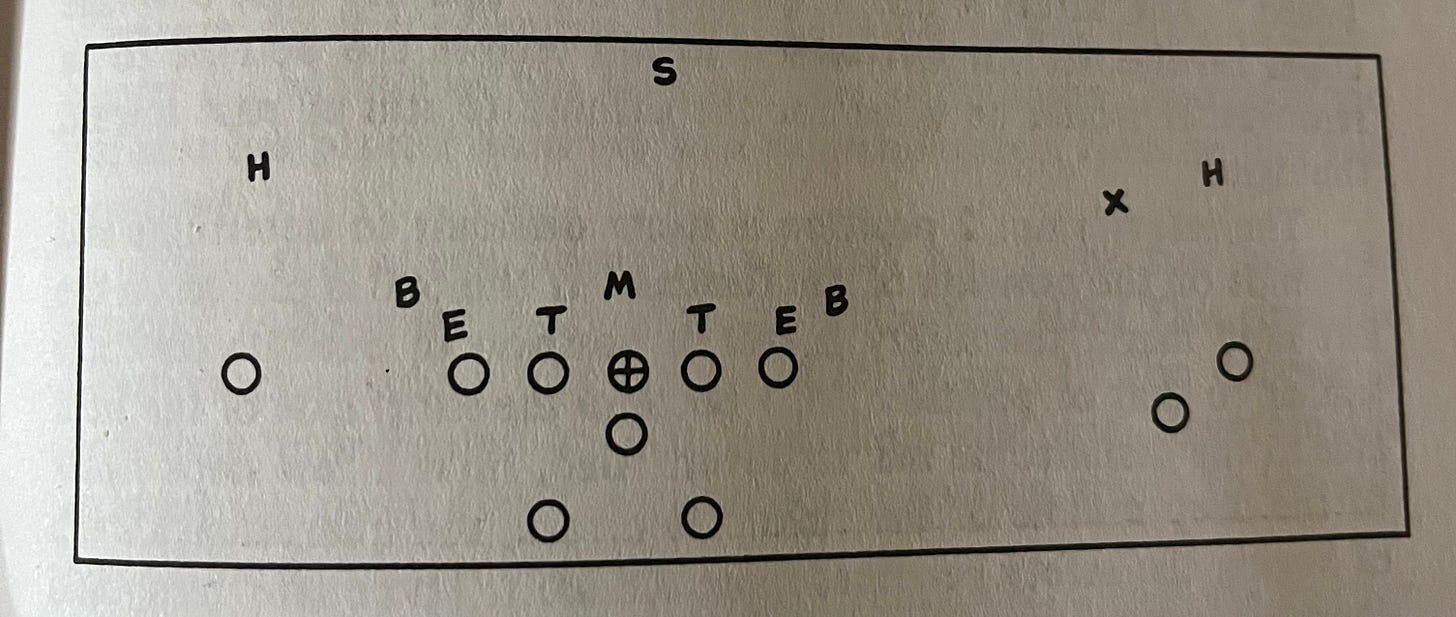Homer Rice gets us thinking about "balance"
How the Triple Option will help you win football games
The Book Under Review
This book lives up to its name (or more so its subtitle): “Here’s the First Complete Guide to One of the Greatest Innovations in Football History!” (we’ll take his word on the claim of “first” but I will back his claim of “one of the greatest innovations” — his passing game is unique).
Summary: Teaching technique is the key to everything
I will be brief in summary: Homer Rice gives a history of the offense, teaches the terminology, and then breaks down every position’s duty in regard to the triple option run game and their innovative pocket pass game.
Rice makes an incredible emphasis (read: argument) on teaching technique. And so each chapter is full of specific details on how to teach the technique of the scheme.
Analysis: A man ahead of his time?
This book came out in 1972 yet its contents are relevant today. The game of football has undoubtedly changed (read this article to remind yourself how crazy/innovative Hal Mumme’s aerial attack was). But after reading this book, it’s clear the debates yesterday are the same today.
WE MUST ESTABLISH THE RUN GAME (this is where we get derailed by the word “balanced”)
Is the Triple Option a balanced offense? Read what Coach Rice has to say:
The plan was to line up in the Cincinnati formation* with the threat of the pocket pass first and the Triple Option second. Many coaches adhere to the opposite. They believe in the run first, which in many cases results in a passing situation on third down and long yardage. In striving for balance, an offensive team must be a threat both passing and running on each down.
*Cincinnati Formation:
This formation surprised me. Coach Rice’s formation uses 20 personnel (2 running backs & 0 tight ends). The split back part is not surprising, but rather the use of the 3 receivers. As Coach Rice explained throughout the book, the purpose was to spread the defense so that the Triple Option could be even more deadly. He could accomplish this because of the approach he detailed above: “the threat of the pocket pass first and the Triple Option second.”
When the defense plays a single high coverage like above (or plays any variation of 2 on 2 to the multiple receivers) then the advantage goes to the receivers. In other words, the offense can be balanced because it will attack where the defense isn’t on any given play (will elaborate in a later post on the teaching method he taught his quarterbacks on how to get into the right play. Read another teaching method here.)
Let’s now dive into Coach Rice’s curious description of a “balanced” offense.
WHAT DOES BALANCE MEAN ANYWAY?
Here’s what the late, great Coach Mike Leach had to say on the subject (you can read the highlights of what he said below the video):
In the written word:
WHAT DOES THIS MEAN?
It is interesting that Coach Leach equates balance with the Wishbone (another Triple Option scheme and one that Rice refers to in the book). Coach Leach’s framing of balance is interesting because it’s seemingly so obvious. Now it’s perfectly natural to think that balance should be defined between pass and run. But let’s explore why we seek balance.
WHAT IS THE GOAL OF “BALANCE?”
Ultimately, it appears that the goal of being “balanced” is about attacking the defense where they aren’t. This is Offense 101, right?
Let’s first think about this concept in the frame of run/pass balance.
Look again at what Coach Rice said: “In striving for balance, an offensive team must be a threat both passing and running on each down.” So for Rice, being balanced isn’t about having a 50/50 split at the end of the game. It’s about having the defense *think* there’s a 50/50 chance of run/pass *before* every snap.
Now we must ask: “does a 50/50 split at the end of a game mean the defense thought you could run or pass at any time?” Absolutely not! Just because your offense achieved a 50/50 split does not mean you were balanced (according to Rice). Why? Because each football play exist in a specific situation. For example, a run on 3rd & 1 is not like a run on 2nd & 12 (for all that’s good in football, please don’t make a habit of running on 2nd & long).
Remember that balance comes from the threat of run or pass on any down, not an after-the-fact statistic. Now that lands us on this question: can you measure to see if you are balanced?
MEASURING BALANCE
If “true” balance is more about the threat, then maybe we must interview the defense after the fact. You might ask, “DC, did you think we could run or pass on any given down?” But no, you ought not ask such a thing because that’s not how you’re going to measure it. For a person adhering to Leach’s definition of balance, you would simply have to look at the distribution of touches among your skill players.
But to truly measure your balance (as Rice describes it), I suppose you must look at the success of your plays. If you’d like to achieve balance by being able to run or pass on any down, then look and see if you did so *successfully*.
At once, I am reminded of what Coach Spurrier once said, “Statistics are for losers and assistant coaches. Head coaches worry about wins and losses.” And stats like how many touches our players got or what the distribution between run and pass looked like are ultimately inconsequential (unless, of course, you’ve got supportive booster parents to satiate and you need to get their sons the ball in order to purchase new uniforms next year — that was a joke).
But let’s get serious and really think about Rice’s approach to balance. At the same time that it is about what is happening before the snap, its real meaning comes from what happens after the snap.
Is your offense able to find success whether by the run or pass on any given down?
This perspective is so interesting because you can’t go out and achieve this balance easily. If you want, you can call plays in such a way that leaves you with equal runs and passes at the end of the night. If you want, you can call plays in such a way that gets the ball to all your skill players. But what you can’t do, is call plays in such a way that all but guarantees the success of your run or pass on any given down (if you’ve figured out how to do that, please hit reply and allow me to “pick your brain”).
WHY DOES THIS CONVERSATION ABOUT BALANCE MATTER?
Certainly if you’ve made it this far you are interested in the above question. Balance matters simply because we think it matters. It is something that we all look at. But Rice (and Leach) flip the way we think about balance on its head. For Leach, balance is about getting the ball to all your skill players (can be accomplished through his Air Raid or a diverse run game like the Triple Option). But for Rice, balance means you’re offense is the type of offense that can run or pass with equal success on any given down.
Now that’s an offense worth exploring. And Rice makes a great case for how his offense does just that through the Triple Option which can get the ball to 3 players on any given run and his use of option routes (we’ll have to explore his unique passing game at a later date, please be on the lookout for that).
In conclusion
In what was supposed to be a straightforward and simple book review, I was derailed by one word: balance. Clearly, this post wasn’t balanced. We didn’t get to talk about the actual technique Coach Rice taught (the real gold in the book) nor did we get to talk about his innovative “Check-with-me” system. All for another time.
Until next time —
Emory Wilhite







